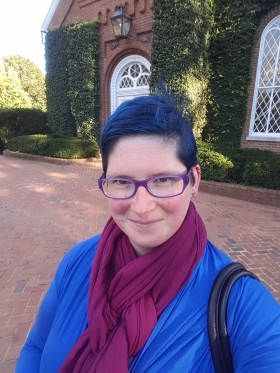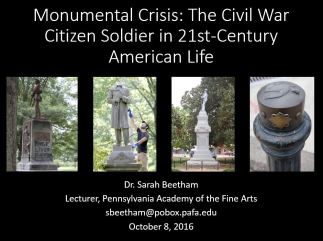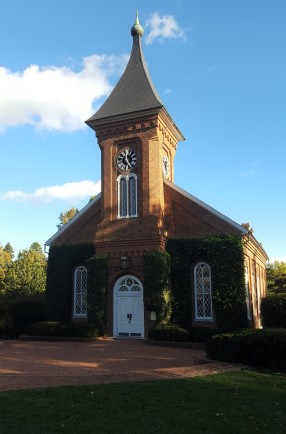 October is always a busy month, both personally and professionally. The semester is in full swing, with fresh lesson planning every week, and grading usually begins to pile up. It’s the best month of fall and the season of my favorite holiday, Halloween, which means haunted houses and corn mazes on the weekend (this year, the Brighton Asylum and Happy Day Farm). And on top of all of that, I generally attend at least one and usually two out-of-town art history conferences. Since 2011, I haven’t missed a trip to the Southeastern College Art Conference, or SECAC. And this year, I was also selected to present a paper at the biennial Association of Historians of American Art (AHAA) symposium, one of my favorite events. AHAA took me to Fort Worth, Texas, from October 6-8, and I just got back from SECAC late last night (with one detour, which I’ll explain in a moment!). It has been an exhausting but stimulating month!
October is always a busy month, both personally and professionally. The semester is in full swing, with fresh lesson planning every week, and grading usually begins to pile up. It’s the best month of fall and the season of my favorite holiday, Halloween, which means haunted houses and corn mazes on the weekend (this year, the Brighton Asylum and Happy Day Farm). And on top of all of that, I generally attend at least one and usually two out-of-town art history conferences. Since 2011, I haven’t missed a trip to the Southeastern College Art Conference, or SECAC. And this year, I was also selected to present a paper at the biennial Association of Historians of American Art (AHAA) symposium, one of my favorite events. AHAA took me to Fort Worth, Texas, from October 6-8, and I just got back from SECAC late last night (with one detour, which I’ll explain in a moment!). It has been an exhausting but stimulating month!
 One of the best things about attending an academic conference is the way it can reinvigorate your commitment to your own work. Lately, I’ve been very consumed with teaching and lesson planning, and my research has been on something of a back burner. But in the leadup to AHAA, I pulled myself together to present “Monumental Crisis: The Civil War Citizen Soldier in 21st-Century American Life,” an overview of my current book project on the ways in which Civil War monuments are impacted by intentional vandalism or iconoclasm; deliberate revision or removal; accidental damage; and the effects of weather or neglect. I received a lot of helpful and encouraging feedback, and I feel a renewed sense of energy to continue developing this project. Hopefully I’ll have a lot more to report soon!
One of the best things about attending an academic conference is the way it can reinvigorate your commitment to your own work. Lately, I’ve been very consumed with teaching and lesson planning, and my research has been on something of a back burner. But in the leadup to AHAA, I pulled myself together to present “Monumental Crisis: The Civil War Citizen Soldier in 21st-Century American Life,” an overview of my current book project on the ways in which Civil War monuments are impacted by intentional vandalism or iconoclasm; deliberate revision or removal; accidental damage; and the effects of weather or neglect. I received a lot of helpful and encouraging feedback, and I feel a renewed sense of energy to continue developing this project. Hopefully I’ll have a lot more to report soon!
 For this year’s iteration of SECAC, I applied to chair a session titled “The Afterlives of Objects: Impermanence in American Art.” The response to the call for papers was quite robust, and so I asked the SECAC organizers about the possibility of a double session, which they granted (thanks to Jennifer Van Horn for stepping up to chair the second session!). Over the course of two sessions on Friday morning, we discussed both mob-led and artist-directed iconoclasm, recontextualization of public monuments, removal and destruction of works of art, conservation, entropy, and neglect. The sessions were well attended and the conversation afterward was quite lively. I was very pleased at how well the speakers’ individual topics dovetailed with one another, and I left SECAC with several pages of notes and new ideas. I always find SECAC to be one of the friendliest art history conferences out there, and the organizers do a great job nurturing young scholars and providing space for first-time panel chairs proposing their new ideas for discussion. Looking forward to next year’s conference in Columbus, Ohio!
For this year’s iteration of SECAC, I applied to chair a session titled “The Afterlives of Objects: Impermanence in American Art.” The response to the call for papers was quite robust, and so I asked the SECAC organizers about the possibility of a double session, which they granted (thanks to Jennifer Van Horn for stepping up to chair the second session!). Over the course of two sessions on Friday morning, we discussed both mob-led and artist-directed iconoclasm, recontextualization of public monuments, removal and destruction of works of art, conservation, entropy, and neglect. The sessions were well attended and the conversation afterward was quite lively. I was very pleased at how well the speakers’ individual topics dovetailed with one another, and I left SECAC with several pages of notes and new ideas. I always find SECAC to be one of the friendliest art history conferences out there, and the organizers do a great job nurturing young scholars and providing space for first-time panel chairs proposing their new ideas for discussion. Looking forward to next year’s conference in Columbus, Ohio!
 On the drive home from SECAC, I decided to make a stop at Washington and Lee University in Lexington, Virginia, to visit the Lee Chapel, burial site of Robert E. Lee. As I was driving down to Roanoke in total darkness last Thursday night, passing through the Shenandoah Valley on Route 81, I noticed that I was passing signs for one Civil War-themed site after another. Of course this makes sense, as the Shenandoah Valley was the site of fierce fighting throughout the war. But I don’t tend to find myself in this part of Virginia too often, and so I decided to use this trip to stop at one site that has been on my mind for some time. The Lee Chapel is the home of a recumbent sculpture of Robert E. Lee by Edward V. Valentine, unveiled in 1883. After Lee’s death in 1870, his wife, Mary Custis Lee, selected the Lee Chapel at the university where he had served as president as his final resting place. Eventually, the chapel became a burial vault for many members of the Lee and Custis families, and a pilgrimage site for Southern heritage tours.
On the drive home from SECAC, I decided to make a stop at Washington and Lee University in Lexington, Virginia, to visit the Lee Chapel, burial site of Robert E. Lee. As I was driving down to Roanoke in total darkness last Thursday night, passing through the Shenandoah Valley on Route 81, I noticed that I was passing signs for one Civil War-themed site after another. Of course this makes sense, as the Shenandoah Valley was the site of fierce fighting throughout the war. But I don’t tend to find myself in this part of Virginia too often, and so I decided to use this trip to stop at one site that has been on my mind for some time. The Lee Chapel is the home of a recumbent sculpture of Robert E. Lee by Edward V. Valentine, unveiled in 1883. After Lee’s death in 1870, his wife, Mary Custis Lee, selected the Lee Chapel at the university where he had served as president as his final resting place. Eventually, the chapel became a burial vault for many members of the Lee and Custis families, and a pilgrimage site for Southern heritage tours.
I left SECAC at about 3:30 (needed to make time for some final schmoozing!) and rolled into Lexington about twenty minutes before the chapel was set to close at 5:00 PM. I walked inside to see Valentine’s sculpture of Lee right up at the front, in the location that the altar would be in most churches. And I found that I was not alone: one of the women who was in the audience during my SECAC panel (whose name I unfortunately do not know!) was also there with a friend. We chatted for a few moments about the conference, and then I turned to contemplate the sculpture.

Also known as a gisant, the recumbent sculpture of a prominent figure reposing in death atop a tomb is an old form, dating at least as far back as the medieval period in western art. It is also a form that greatly appeals to the more macabre side of my personality, and so I have a tendency to seek these sculptures out. One of the most arresting gisants by an American artist is the effigy made by Frank Duveneck for the tomb of his wife, Elizabeth Boott Duveneck, whose untimely death left him devastated. Several copies of this sculpture were made and given to various American museums, including the Metropolitan Museum of Art.
 After knowing this statue from photographs and building it up in my head over so many years, I found the experience of it in person to be a bit of a letdown. Something about the marble seemed almost too clean, too starkly white, to the point that the more delicate details of the monument felt washed out. I’m not sure whether it was the lighting in the chapel, the disconnect between the sculpture and the surrounding space, or the “fish out of water” feeling that often comes over me when I visit a site that overtly reveres the Confederacy, but viewing this sculpture made me supremely uneasy. So, partly to soothe this uneasiness, and partly to let the old man know that not everyone who visits his grave approves of his legacy, I hummed a verse and chorus of “The Battle Cry of Freedom” under my breath:
After knowing this statue from photographs and building it up in my head over so many years, I found the experience of it in person to be a bit of a letdown. Something about the marble seemed almost too clean, too starkly white, to the point that the more delicate details of the monument felt washed out. I’m not sure whether it was the lighting in the chapel, the disconnect between the sculpture and the surrounding space, or the “fish out of water” feeling that often comes over me when I visit a site that overtly reveres the Confederacy, but viewing this sculpture made me supremely uneasy. So, partly to soothe this uneasiness, and partly to let the old man know that not everyone who visits his grave approves of his legacy, I hummed a verse and chorus of “The Battle Cry of Freedom” under my breath:
We will welcome to our number the loyal, true and brave,
Shouting the battle cry of freedom!
And although they may be poor, not a man shall be a slave,
Shouting the battle cry of freedom!The Union forever, hurrah, boys, hurrah!
Down with the traitor, up with the star.
While we rally ’round the flag, boys, rally once again,
Shouting the battle cry of freedom.
 Outside the Lee Chapel, I found another Civil War oddity that has long amused me: the grave of Lee’s horse, Traveller. After Traveller’s death in 1871, he was first buried on the grounds of Washington and Lee University, but then exhumed around 1875, and his bones were bleached and mounted for display. But during their time on display, they were often vandalized by students carving initials into them, and so finally Traveller was laid to rest beside the Lee Chapel in 1971. Visitors sometimes leave carrots at his grave; I was unable to find any before my impromptu visit to Lexington. This is not the only weird site associated with a Civil War horse, and someday I’d like to visit them all.
Outside the Lee Chapel, I found another Civil War oddity that has long amused me: the grave of Lee’s horse, Traveller. After Traveller’s death in 1871, he was first buried on the grounds of Washington and Lee University, but then exhumed around 1875, and his bones were bleached and mounted for display. But during their time on display, they were often vandalized by students carving initials into them, and so finally Traveller was laid to rest beside the Lee Chapel in 1971. Visitors sometimes leave carrots at his grave; I was unable to find any before my impromptu visit to Lexington. This is not the only weird site associated with a Civil War horse, and someday I’d like to visit them all.
Now that my October travels are over, I look forward to settling down to finish out the semester over the next two months!
